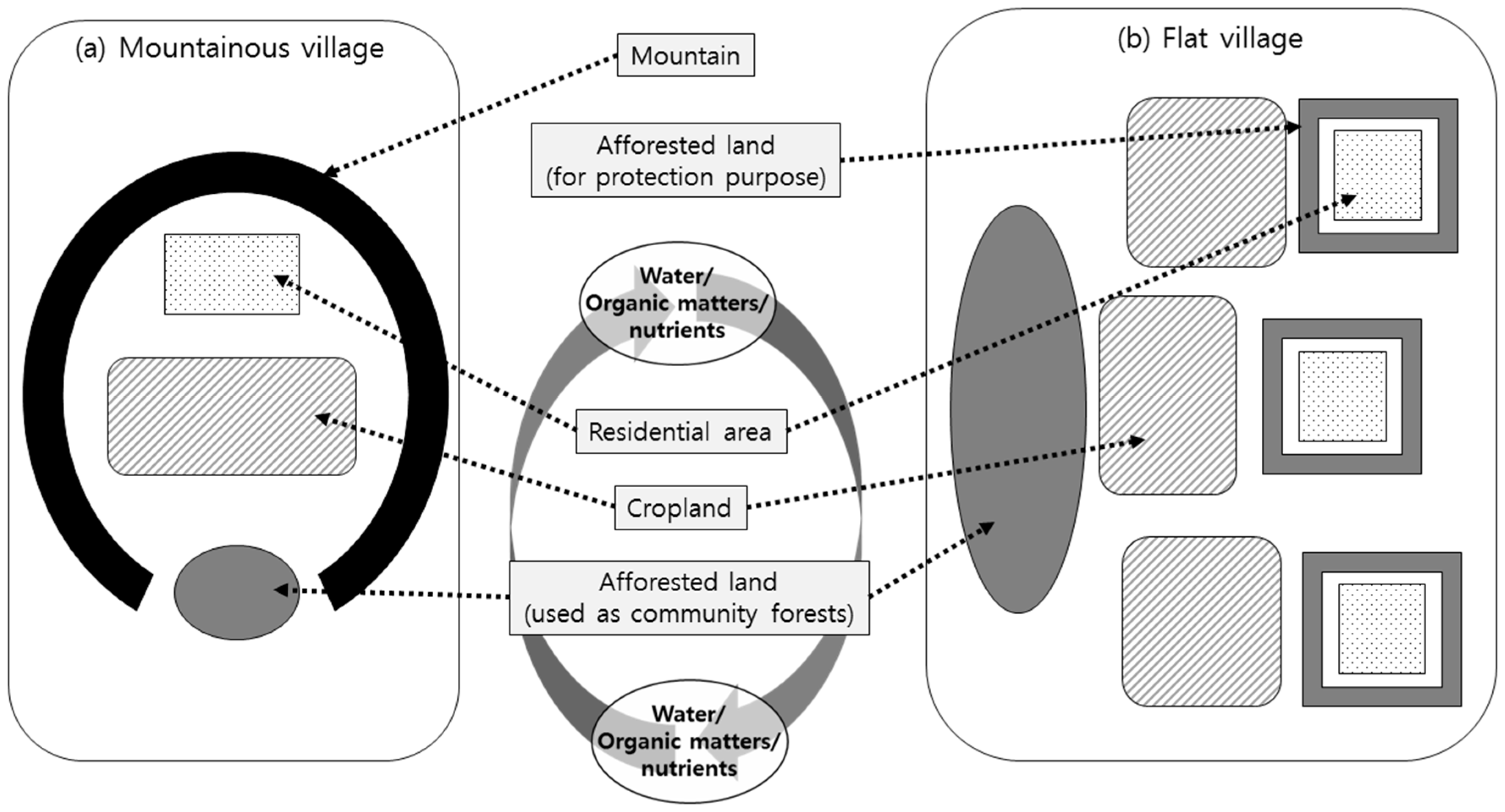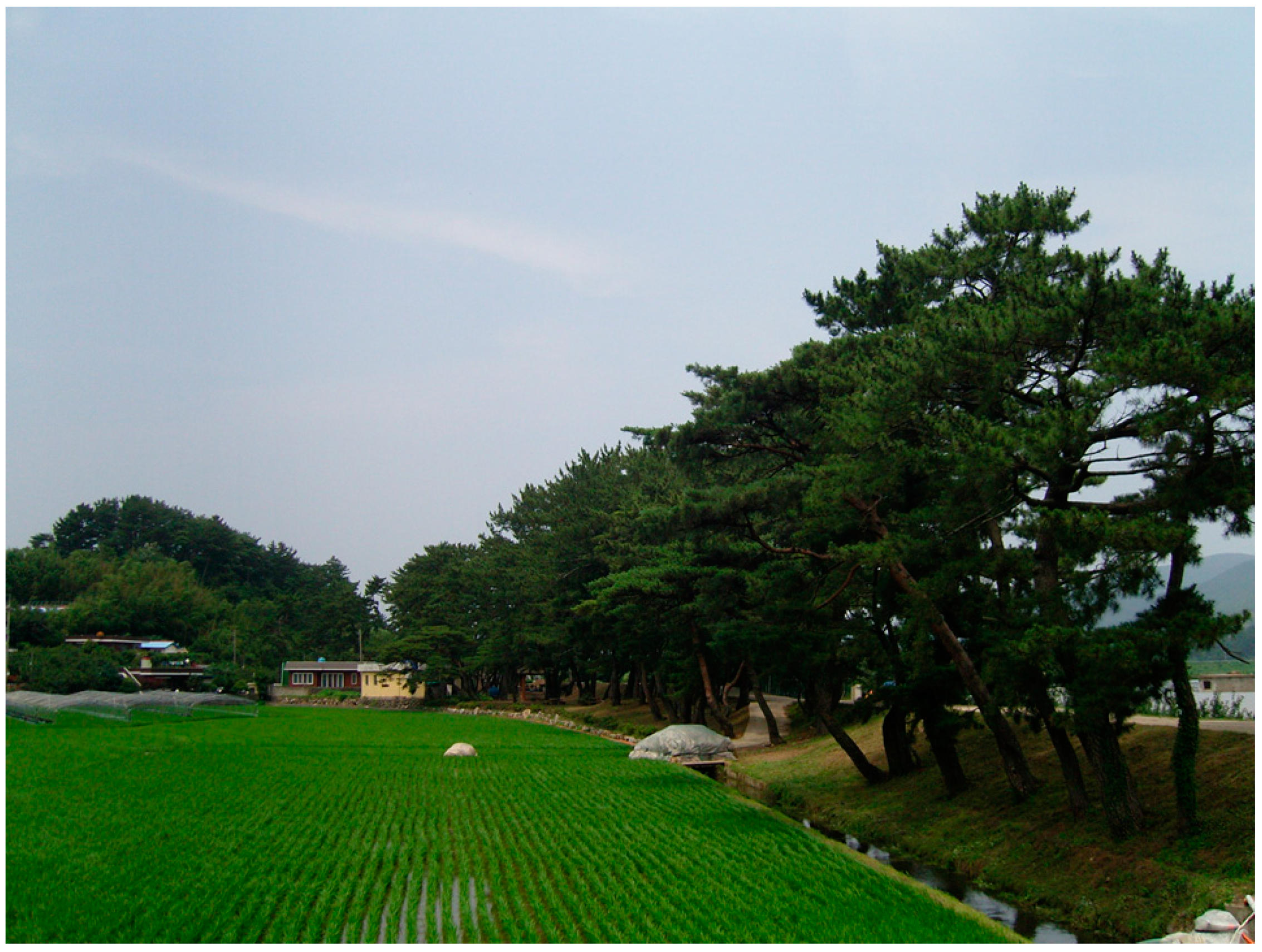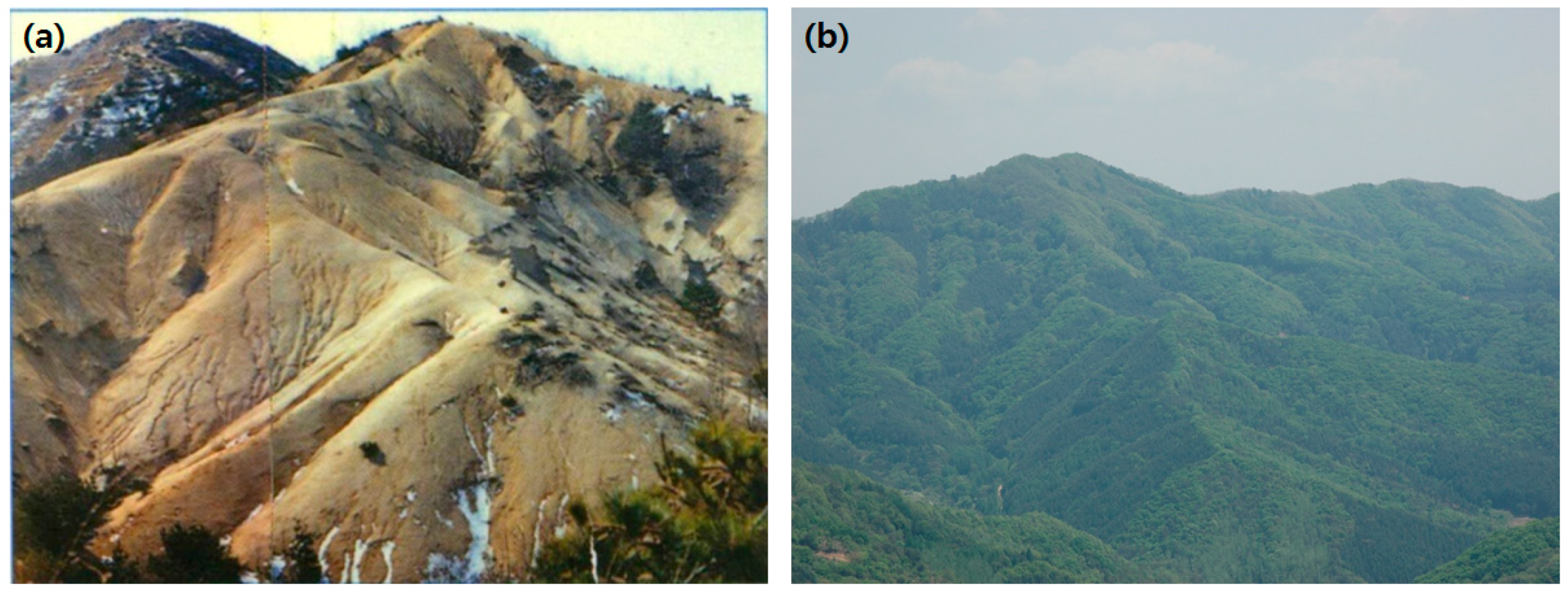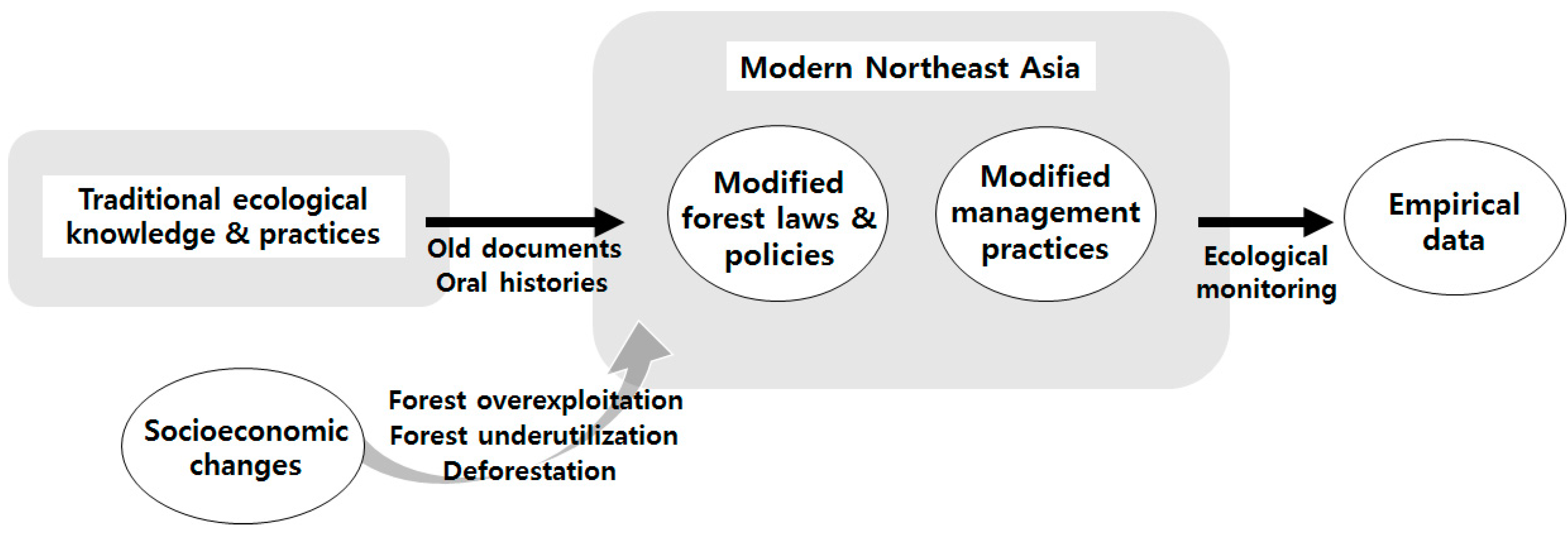The Contribution of Traditional Ecological Knowledge and Practices to Forest Management: The Case of Northeast Asia
Abstract
:1. Introduction
2. Traditional Ecological Knowledge and Practices in Ancient Northeast Asia
2.1. The Fengshui Concept within Forestry
2.2. The Historical Forest Policies and Practices
2.3. Community Forestry
3. Implementation of Traditional Ecological Knowledge and Community Forestry in Modern China, Japan, and South Korea
3.1. China
3.2. Japan
3.3. South Korea
4. Implications
5. Conclusions
Acknowledgments
Author Contributions
Conflicts of Interest
References
- Berkes, F.; Colding, J.; Folke, C. Rediscovery of traditional ecological knowledge as adaptive management. Ecol. Appl. 2000, 10, 1251–1262. [Google Scholar] [CrossRef]
- Berkes, F. Traditional ecological knowledge in perspective. In Traditional Ecological Knowledge: Concepts and Cases; Inglis, J.T., Ed.; International Program on Traditional Ecological Knowledge, International Development Research Centre: Ottawa, ON, Canada, 1993; pp. 1–9. ISBN 1-895926-00-9. [Google Scholar]
- Guan, C. Study on knowledge and practice on function of conserving water and soil of forests in ancient China. Sci. Soil Water Conserv. 2004, 2, 105–110. (In Chinese) [Google Scholar]
- Youn, Y.-C.; Liu, J.; Sakuma, D.; Kim, K.; Masahiro, I.; Shin, J.-H.; Yuan, J. Northeast Asia. In Traditional Forest-Related Knowledge; Parrotta, J.A., Trosper, R.L., Eds.; Springer: Dordrecht, The Netherlands, 2012; pp. 281–313. ISBN 978-94-007-2143-2. [Google Scholar]
- Park, H.; Lee, J.Y.; Song, M. Scientific activities responsible for successful forest greening in Korea. For. Sci. Technol. 2017, 13, 1–8. [Google Scholar] [CrossRef]
- Bürgi, F.; Gimmi, U.; Stuber, M. Assessing traditional knowledge on forest uses to understand forest ecosystem dynamics. For. Ecol. Manag. 2013, 289, 115–122. [Google Scholar] [CrossRef]
- Lee, E.; Krasny, M.E. Adaptive capacity in community forest management: A systematic review of studies in East Asia. Environ. Manag. 2017, 59, 34–49. [Google Scholar] [CrossRef] [PubMed]
- Ramakrishnan, P.S. Traditional forest knowledge and sustainable forestry: A north-east India perspective. For. Ecol. Manag. 2007, 249, 91–99. [Google Scholar] [CrossRef]
- Watanabe, T.; Okuyama, M.; Fukamachi, K. A review of Japan’s environmental policies for Satoyama and Satoumi landscape restoration. Glob. Environ. Res. 2012, 16, 125–135. [Google Scholar] [CrossRef]
- Berglund, B.E.; Kitagawa, J.; Lagerås, P.; Nakamura, K.; Sasaki, N.; Yasuda, Y. Traditional farming landscapes for sustaining living in Scandinavia and Japan: Global revival through the Satoyama Initiative. Ambio 2014, 43, 559–578. [Google Scholar] [CrossRef] [PubMed]
- Herrmann, T.M.; Torri, M.-C. Changing forest conservation and management paradigms: Traditional ecological knowledge systems and sustainable forestry: Perspectives from Chile and India. Int. J. Sustain. Dev. World Ecol. 2009, 16, 392–403. [Google Scholar] [CrossRef]
- Coggins, C.; Chevrier, J.; Dwyer, M.; Longway, L.; Xu, L.; Tiso, P.; Li, Z. Village Fengshui forests of southern China: Culture, history, and conservation status. Asia Netw. Exch. 2012, 19, 52–67. [Google Scholar] [CrossRef]
- Chun, Y.W.; Tak, K.-I. Songgye, a traditional knowledge system for sustainable forest management in Choson dynasty of Korea. For. Ecol. Manag. 2009, 257, 2022–2026. [Google Scholar] [CrossRef]
- Kong, W.-S.; Lee, S.H.; Bang, J.-Y.; Hong, S.-C.; Choi, S.-K. The History of Korean Forests; The Society for Forests and Culture: Seoul, Korea, 2014; pp. 134–185. ISBN 978-89-93453-21-8. (In Korean) [Google Scholar]
- Korea Forest Research Institute. History of the Tree Selection System and Its Application; Korea Forest Research Institute: Seoul, Korea, 2009; pp. 7–73. ISBN 978-89-8176-543-9. (In Korean) [Google Scholar]
- Kwon, S.-K. An analysis of Bongsan policy in the late era of Chosun dynasty. Korean Policy Sci. Rev. 2007, 11, 81–104. (In Korean) [Google Scholar]
- Dai, L.; Zhao, W.; Shao, G.; Lewis, B.J.; Yu, D.; Zhou, L.; Zhou, W. The progress and challenges in sustainable forestry development in China. Int. J. Sustain. Dev. World Ecol. 2013, 20, 394–403. [Google Scholar] [CrossRef]
- Xu, J.; Tao, R.; Amacher, G.S. An empirical analysis of China’s state-owned forests. For. Policy Econ. 2004, 6, 379–390. [Google Scholar] [CrossRef]
- Takeuchi, K.; Ichikawa, K.; Elmqvist, T. Satoyama landscape as social-ecological system: Historical changes and future perspective. Curr. Opin. Environ. Sustain. 2016, 19, 30–39. [Google Scholar] [CrossRef]
- Tak, K.; Chun, Y.; Wood, P.M. The South Korean forest dilemma. Int. For. Rev. 2007, 9, 548–557. [Google Scholar] [CrossRef]
- Bae, J.S.; Joo, R.W.; Kim, Y.-S. Forest transition in South Korea: Reality, path and drivers. Land Use Policy 2012, 29, 198–207. [Google Scholar] [CrossRef]
- Fang, J.; Guo, Z.; Hu, H.; Kato, T.; Muraoka, H.; Son, Y. Forest biomass carbon sinks in East Asia, with special reference to the relative contributions of forest expansion and forest growth. Glob. Chang. Biol. 2014, 2019–2030. [Google Scholar] [CrossRef] [PubMed]
- Han, K.-T. Traditional Chinese site selection—Fang Shui: An evolutionary/ecological perspective. J. Cult. Geogr. 2001, 19, 75–96. [Google Scholar] [CrossRef]
- Wu, Y.-B. Origin of Fengshui woods and its enlightenment to modern society. J. Landsc. Res. 2011, 3, 96–99. [Google Scholar]
- Chen, B.; Nakama, Y.; Kurima, G. Layout and composition of house-embracing trees in an island Feng shui village in Okinawa, Japan. Urban For. Urban Green. 2008, 7, 53–61. [Google Scholar] [CrossRef]
- Whang, B.-C.; Lee, M.W. Landscape ecology planning principles in Korean Feng-shui, Bi-bo woodlands and ponds. Landsc. Ecol. Eng. 2006, 2, 147–162. [Google Scholar] [CrossRef]
- Yuan, J.; Liu, J. Fengshui forest management by the Buyi ethnic minority in China. For. Ecol. Manag. 2009, 257, 2002–2009. [Google Scholar] [CrossRef]
- Park, J.-C. Concept and case of village grove. Keimyung Korean Stud. J. 2006, 33, 233–262. (In Korean) [Google Scholar]
- Takeuchi, K. Rebuilding the relationship between people and nature: The Satoyama Initiative. Ecol. Res. 2010, 25, 891–897. [Google Scholar] [CrossRef]
- Miyaura, T. Satoyama—A place for preservation of biodiversity and environmental education. Die Bodenkultur 2009, 60, 23–29. [Google Scholar]
- Koh, I.; Kim, S.; Lee, D. Effects of Bibosoop plantation on wind speed, humidity, and evaporation in a traditional agricultural landscape of Korea: Field measurements and modeling. Agric. Ecosyst. Environ. 2010, 135, 294–303. [Google Scholar] [CrossRef]
- Lee, K.-S. Bee-bo forest: Traditional landscape ecological forest in Korea. In Landscape Ecological Applications in Man-Influenced Areas: Linking Man and Nature Systems; Hong, S.-K., Nakagoshi, N., Morimoto, Y., Eds.; Springer: Dordecht, The Netherlands, 2008; pp. 389–394. ISBN 978-1-4020-5487-7. [Google Scholar]
- Koh, I.; Reineking, B.; Park, C.-R.; Lee, D. Dispersal potential mediates effects of local and landscape factors on plant species richness in Maeulsoop forests of Korea. J. Veg. Sci. 2015, 26, 631–642. [Google Scholar] [CrossRef]
- Iwamoto, J. The development of Japanese forestry. In Forestry and the Forest Industry in Japan; Iwai, Y., Ed.; University of British Columbia Press: Vancouver, BC, Canada, 2002; pp. 3–9. ISBN 0-7748-0882-9. [Google Scholar]
- Han, J.-S. The development of forests and the formation of policy for cultivating pine trees in the period from Taejo to Sejong of Joseon. Sahak Yonku 2013, 111, 42–81. (In Korean) [Google Scholar]
- Gillett, P.L. The village gilds of old Korea. Trans. Korea Branch R. Asiat. Soc. 1913, 4, 13–44. [Google Scholar]
- Yuan, J.; Wu, Q.; Liu, J. Understanding indigenous knowledge in sustainable management of natural resources in China: Taking two villages from Guizhou Proince as a case. For. Policy Econ. 2012, 22, 47–52. [Google Scholar] [CrossRef]
- Hasegawa, M.; Pulhin, J.M.; Inoue, M. Facing the challenge of social forestry in Japan: The case of reviving harmonious coexistence between forest and people in Okayama prefecture. Small-Scale For. 2013, 12, 257–275. [Google Scholar] [CrossRef]
- Yu, D.J.; Anderies, J.M.; Lee, D.; Perez, I. Transformation of resource management institutions under globalization: The case of Songgye community forests in South Korea. Ecol. Soc. 2014, 19, 2. [Google Scholar] [CrossRef]
- Kang, S.-B. The practice of Songgye on the villages around Guksa-bong, Gyeryongsan—Focus on the Songgye of Hyanghan-ri, Gyeryong-shi. Korean J. Folk Stud. 2009, 24, 97–121. (In Korean) [Google Scholar]
- Yu, D.; Zhou, L.; Zhou, W.; Ding, H.; Wang, Q.; Wang, Y.; Wu, X.; Dai, L. Forest management in Northeast China: History, problems, and challenges. Environ. Manag. 2011, 48, 1122–1135. [Google Scholar] [CrossRef] [PubMed]
- Gao, H.; Ouyang, Z.; Chen, S.; Koppen, C.S.A. Role of culturally protected forests in biodiversity conservation in Southeast China. Biodivers. Conserv. 2013, 22, 531–544. [Google Scholar] [CrossRef]
- State Forestry Administration. National Report on Sustainable Forest Management; China Forestry Publishing House: Beijing, China, 2013; pp. 175–210.
- He, J.; Zhou, Z.; Weyerhaeuser, H.; Xu, J. Participatory technology development for incorporating non-timber forest products into forest restoration in Yunnan, Southwest China. For. Ecol. Manag. 2009, 257, 2010–2016. [Google Scholar] [CrossRef]
- He, J.; Sikor, T. Looking beyond tenure in China’s collective forest tenure reform: Insights from Yunnan Province, Southwest China. Int. For. Rev. 2017, 19, 29–41. [Google Scholar] [CrossRef]
- Liang, L.; Shen, L.; Yang, W.; Yang, X.; Zhang, Y. Building on traditional shifting cultivation for rotational agroforestry experiences from Yunnan, China. For. Ecol. Manag. 2009, 257, 1989–1994. [Google Scholar] [CrossRef]
- The Forest Law of the People’s Republic of China; Democracy and Law of China Press: Beijing, China, 2008; ISBN 9787802192225. (In Chinese)
- Liu, J.; Innes, J.L. Participatory forest management in China: Key challenges and ways forward. Int. For. Rev. 2015, 17, 477–484. [Google Scholar] [CrossRef]
- Ichikawa, K.; Okubo, N.; Okubo, S.; Takeuchi, K. Transition of the Satoyama landscape in the urban fringe of the Tokyo metropolitan area from 1880 to 2001. Landsc. Urban Plan. 2006, 78, 398–410. [Google Scholar] [CrossRef]
- Igarashi, T.; Masaki, T.; Nagaike, T.; Tanaka, H. Species richness of the understory woody vegetation in Japanese cedar plantations declines with increasing number of rotations. J. For. Res. 2016, 21, 291–299. [Google Scholar] [CrossRef]
- Yiu, E. Noto peninsula after GIAHS designation: Conservation and revitalization efforts of Noto’s satoyama and satoumi. J. Resour. Ecol. 2014, 5, 364–369. [Google Scholar] [CrossRef]
- Yao, Z.; Xin, Z.-J.; Wu, Y.-M.; You, H.L. Environmental management mode of satoyama in Japan and its enlightenment to construction of new country-side in China. J. Ecol. Rural Environ. 2017, 33, 769–774. (In Chinese) [Google Scholar]
- Terada, T.; Yokohari, M.; Bolthouse, J.; Tanaka, N. “Refueling” satoyama woodland restoration in Japan: Enhancing restoration practice and experiences through woodfuel utilization. Nat. Cult. 2010, 5, 251–276. [Google Scholar] [CrossRef]
- Katoh, K.; Sakai, S.; Takahashi, T. Factors maintaining species diversity in Satoyama, a traditional agricultural landscape of Japan. Biol. Conserv. 2009, 142, 1930–1936. [Google Scholar] [CrossRef]
- Fujiwara, A.; Washitani, I. Dependence of Asian honeybee on deciduous woody plants for pollen resource during spring to mid-summer in northern Japan. Entomol. Sci. 2017, 20, 96–99. [Google Scholar] [CrossRef]
- Kobayashi, S.; Abe, S.; Matsuki, R. Genetic structure of a Japanese brown frog (Rana japonica) population implies severe restriction of gene flow caused by recent urbanization in a Satoyama landscape. Mitochondrial DNA 2013, 24, 697–704. [Google Scholar] [CrossRef] [PubMed]
- Lee, K.-J. Saemaul Undong and Foreset Rehabilitation in Korea: Saemaul Income Boosting Project and the Role of the Village Forestry Cooperative; Ministry of Strategy and Finance: Sejong, Korea, 2013; pp. 315–328. (In Korean)
- Korea Forest Service. Lessons Learned from the Republic of Korea’s National Reforestation Programme; Korea Forest Service: Daegu, Korea, 2014; pp. 1–42. ISBN 92-9225-579-7.
- Choe, B.-T. The developments and character of setting up the forestry mutual-aid society in 1945~1960s. Sahak Yonku 2008, 90, 291–336. (In Korean) [Google Scholar]
- Park, M.S.; Lee, H. Legal opportunities for public participation in forest management in the Republic of Korea. Sustainability 2016, 8, 369. [Google Scholar] [CrossRef]
- Lee, J.; Lim, C.-H.; Kim, G.S.; Markandya, A.; Chowdhury, S.; Kim, S.J.; Lee, W.-K.; Son, Y. Economic viability of the national-scale forestation program: The case of success in the Republic of Korea. Ecosyst. Serv. 2018, 29, 40–46. [Google Scholar] [CrossRef]
- Korea Forest Service. Restoration Cases of the Traditional Maeulsoop; Korea Forest Service: Daegu, Korea, 2015; pp. 1–171. (In Korean)
- Lee, E.; Krasny, M.E. The role of social learning for social-ecological systems in Korean village groves restoration. Ecol. Soc. 2015, 20, 42. [Google Scholar] [CrossRef]
- Liu, J.; Liu, X. Transforming nomadic traditions to biodiversity-friendly livelihoods from the perspective of traditional forest-related knowledge: The successful story of H village of Yunnan Province in China. In Satoyama Initiative Thematic Review Volume 2; Ichikawa, K., Subramanian, S.M., Chakraborty, S., Eds.; United Nations University Institute for the Advanced Study of Sustainability: Tokyo, Japan, 2016; pp. 13–25. ISBN 978-92-808-4573-0. [Google Scholar]
- He, J.; Xu, J. Is there decentralization in North Korea? Evidence and lessons from the sloping land management program 2004–2014. Land Use Policy 2017, 61, 113–125. [Google Scholar] [CrossRef]
- Koike, O. Rehabilitation, conservation, and utilization of satoyama ecosystems and human well-being: A case of Kanagawa Prefecture in Japan. Yokohama J. Soc. Sci. 2017, 22, 41–54. [Google Scholar]
- Fuchigami, Y.; Hara, K.; Uwasu, M.; Kurimoto, S. Analysis of the mechanism hindering sustainable forestry operations: A case study of Japanese forest management. Forests 2016, 7, 182. [Google Scholar] [CrossRef]




| Century | Policies and Practices |
|---|---|
| Third | Pinus densiflora Sieb. and Zucc. afforestation near royal tombs and palaces |
| Eighth | Afforestation and replanting of Pinus koraiensis Sieb. and Zucc., Juglans mandshurica Maxim., and Morus alba L. |
| Tenth | Castanea spp. and Pyrus spp. orchard establishment |
| Fifteenth | Law defining punishiment aginst ilegal logging and forest fire setting in Pinus densiflora forests |
| Fifteenth | Law establishing locally specialized offices for selecting plantation species according to economic values and local environments |
| Seventeenth | Promotion of community forestry groups for patrolling local Pinus densiflora forests |
| Eighteenth | Encouragement of pruning activities of Pinus densiflora seedlings |
| Nineteenth | Promotion of land clearing and weeding activities in young Pinus densiflora plantations |
| Site Index * | Cool Temperate Central Region | Cool Temperate Southern Region | Warm Temperate Region |
|---|---|---|---|
| (1) | Larix kaempferi (Lamb.) Carr., Castanea crenata Siebold & Zucc., Populus spp. | Cryptomeria japonica D. Don, Paulownia coreana Uyeki, Castanea crenata | Cryptomeria japonica, Paulownia coreana, Castanea crenata |
| (2) | Larix kaempferi, Castanea crenata, Populus spp., Pinus koraiensis | Chamaecyparis obtusa Sieb. and Zucc., Populus spp., Castanea crenata | Chamaecyparis obtusa, Cryptomeria japonica, Paulownia coreana |
| (3) | Populus spp., Pinus koraiensis, Pinus thunbergii Parl., Robinia pseudoacacia L. | Populus spp., Pinus thunbergii, Chamaecyparis obtusa, Robinia pseudoacacia | Pinus thunbergii, Chamaecyparis obtusa |
| (4) | Pinus rigida Mill., Pinus thunbergii, Robinia pseudoacacia | Pinus rigida, Pinus thunbergii, Robinia pseudoacacia | Pinus rigida, Pinus thunbergii, Robinia pseudoacacia |
| (5) | Alnus japonica (Thunb.) Steud., Pinus rigida | Alnus japonica, Pinus rigida | Alnus japonica, Pinus rigida |
© 2017 by the authors. Licensee MDPI, Basel, Switzerland. This article is an open access article distributed under the terms and conditions of the Creative Commons Attribution (CC BY) license (http://creativecommons.org/licenses/by/4.0/).
Share and Cite
Kim, S.; Li, G.; Son, Y. The Contribution of Traditional Ecological Knowledge and Practices to Forest Management: The Case of Northeast Asia. Forests 2017, 8, 496. https://doi.org/10.3390/f8120496
Kim S, Li G, Son Y. The Contribution of Traditional Ecological Knowledge and Practices to Forest Management: The Case of Northeast Asia. Forests. 2017; 8(12):496. https://doi.org/10.3390/f8120496
Chicago/Turabian StyleKim, Seongjun, Guanlin Li, and Yowhan Son. 2017. "The Contribution of Traditional Ecological Knowledge and Practices to Forest Management: The Case of Northeast Asia" Forests 8, no. 12: 496. https://doi.org/10.3390/f8120496
APA StyleKim, S., Li, G., & Son, Y. (2017). The Contribution of Traditional Ecological Knowledge and Practices to Forest Management: The Case of Northeast Asia. Forests, 8(12), 496. https://doi.org/10.3390/f8120496




